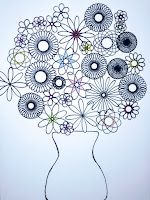Spirograph Designs
Learning Targets
- I can create an original Spirograph Design using computer techniques learned in class
- Use monochromatic colors (light blue, dark blue, blue), line types (contour, outline, thick, thin), and texture (implied, actual, visual) inspired by British Engineer (1918-2002) Denys Fisher
- Use mathematical concepts (trigonometry, radius, turtle python module) and design principles (movement, balance, composition) based on Contemporary Art
- Define Spirograph (a simple drawing game that uses working gears to create an image)
Lesson One
Day One, Art Start
1. Eight Circles (2009) Tony Orrico2. Read The Art of Spiral Drawing: Learn to Create Spiral Art and Geometric Drawings using pencil, pen, and more by Jonathan Stephen Harris
3. Discussion Questions "The modern day Spirograph toy was first brought to the public eye in 1965 by its inventor Denys Fisher, at the Nurmberg International Toy Fair. Originally developed as a mathematical drafting tool, Toy Company Kenner purchased Spirograph and relaunched as a dieting toy for children. Spirograph uses rings, wheels, and pens to create curves and loops, which form an intricate design. What simplified mathematical concepts do you use for a Spirograph design? How would you think the symmetry of these designs affects how the viewer feels about this art? What impact does the symmetry of Spirograph designs have on how people respond to the designs? Do these shapes look familiar? Have you played with a spirograph before? What are your favorite patterns to create?"
Lesson Activities
1. Use a pencil to draw shape variation (geometric, square, rectangle) of the outline of object (butterfly, flowers, leaves) of Spirograph Art2. Use pattern (swirls, dots, waves, stripes) to fill in the positive space (image) of the Spirograph Designs
3. Use pattern (swirls, dots, waves, stripes) to fill in the negative space (background) of the Spirograph Designs
Day Two, Art Start
1. Retrieve Spirograph Designs for Assigned Table2. Circle Studio Impression (2011) Tony Orrico
3. Discussion Questions "What can you tell me about your picture? What title would you give this work? Why did you use these colors for your artwork? How were you feeling when you made this picture? How do you hope other people will feel when they look at your picture? If you could make this picture again, what would you do differently? What can be found behind the artwork? What is your favorite part about this picture? Where did you get your idea? What part do you enjoy the most?"
Lesson Activities
1. Use monochromatic colors (light blue, dark blue, blue) to fill in the positive space (image) of the Spirograph Designs2. Use monochromatic colors (light blue, dark blue, blue) to fill in the negative space (background) of the Spirograph Designs
3. Use line types (horizontal, vertical, diagonal) to fill in the negative space (background) of the Spirograph Designs
Day Three, Art Start
1. Retrieve Spirograph Designs for Assigned Table2. Set Up Studio Area (computer, glue sticks, scissors)
Lesson Activities
1. Add highlights (reflective light, light source) to positive space (image) of Spirograph Designs2. Add shadows (cast shadow, shadow) to negative space (background) of Spirograph Designs
3. Use stop motion program (iMotion, FlipaClip, Stop Motion) to add an animation to the Spirograph Designs






























